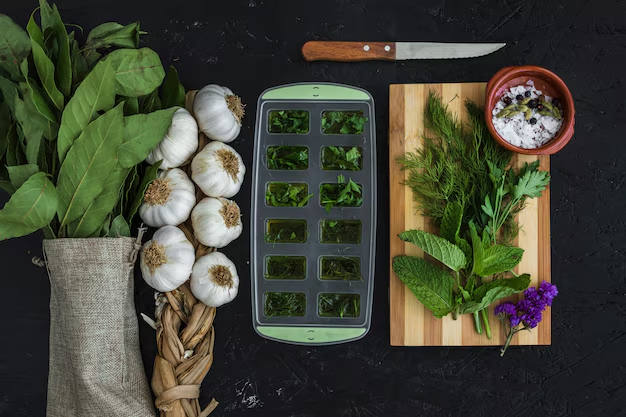Fresh and Crisp: Your Guide to Keeping Greens Fresh in the Refrigerator 🌿
Picture this: You’ve just returned home from the farmer’s market, arms heavy with fresh greens that promise delicious salads and healthy meals. You open the refrigerator door, stash them away, and close it with a satisfying click. Fast forward a few days, and you face a common dilemma – your once-vibrant greens look sad, wilty, and unappealing. How do you keep your greens fresh and crisp longer in the refrigerator? Let's dive in to discover the secrets of extending the shelf life of your greens, ensuring they remain a vibrant addition to your meals.
Why Freshness Matters 🥗
First things first, let's explore why maintaining the freshness of greens is so important. Fresh greens not only enhance the taste and texture of your meals but are also packed with essential nutrients. When greens start to deteriorate, they lose their nutritional value, meaning you're not getting the full health benefits they offer. Luckily, with the right techniques, you can preserve their freshness, nutrients, and flavor.
The Science Behind Greens Deterioration 🧪
Understanding how greens lose their freshness is key to preventing it. Most greens are composed of a high water content. When stored improperly, they lose moisture, which leads to wilting and spoilage. Additionally, exposure to air and ethylene gas (released by some fruits) can accelerate the decay process. By controlling these factors, you can significantly prolong the freshness of your greens.
Choosing the Right Container 🥬
Containers matter when storing greens. The right kind helps maintain humidity levels and minimizes air exposure. Here’s what you should consider:
- Plastic Containers with Lids: These are excellent for locking in moisture without causing dampness. They should be airtight but have small vents or a breathable layer to allow excess humidity to escape.
- Glass Jars: These work well for storing smaller greens like herbs. The airtight nature keeps them hydrated while preventing excess moisture buildup.
- Reusable Silicone Bags: Eco-friendly and versatile, silicone bags are great for preventing air contact and keeping greens fresh.
Quick Tips for Containers:
- Ensure containers are clean and dry before use.
- Avoid overcrowding. Store greens loosely packed.
Washing and Drying Techniques 🧼
Proper washing and drying optimizes freshness:
- Wash when necessary: Only wash your greens when you’re ready to use them or if they’re visibly dirty. Excess water can shorten their shelf life.
- Gentle Rinse: Use cold water and a light touch to avoid bruising.
- Dry Thoroughly: Utilize a salad spinner to remove excess water. Pat them dry with clean towels to eliminate remaining moisture.
Why Dry Greens Last Longer:
Moisture promotes microbial growth and wilting. Keeping greens dry ensures longevity.
Ideal Refrigerator Conditions ❄️
Creating the right environment in your fridge is crucial for the longevity of your greens:
- Temperature Settings: Ensure the fridge is set between 35°F and 40°F. This range is cold enough to slow decay without freezing the leaves.
- Humidity Control: Use the crisper drawer with adjustable humidity settings. Set it to 'high' humidity for leafy greens.
Pro-Tip:
Place a paper towel in the storage container. It absorbs excess moisture while maintaining the optimal humidity level.
Organizing Your Fridge 🍏
Arrangement plays a role in preserving greens:
- Top Shelf: Ideal for ready-to-eat greens. The consistent temperature avoids premature spoilage.
- Crisper Drawer: Best for longer-term storage. Use baskets for separation.
- Avoid the Door: Temperature fluctuations are common in the door compartment, which can cause greens to spoil faster.
Ethylene Sensitivity and Storage 🥑
Some fruits and vegetables release ethylene gas, which can accelerate the ripening and spoilage of greens. Here’s how to avoid the ethylene trap:
- Separate Ethylene-Producers: Keep greens away from fruits like apples, bananas, and avocados.
- Use Greens-only Drawers: Designating a specific drawer for greens helps in isolating them from ethylene.
Visual Guide: Ethylene Producers 🚫
- Apples
- Bananas
- Kiwis
- Tomatoes
- Avocados
Extending the Shelf Life: Best Practices 📝
Let's summarize some do's and don'ts to maximize freshness:
✔️ Do:
- Store greens in breathable containers.
- Use paper towels to manage moisture.
- Separate ethylene-releasing produce.
❌ Don’t:
- Overcrowd containers.
- Store in fridge areas with high temperature fluctuations.
- Allow greens to become too moist.
Creative Solutions and Hacks 🎨
Here are some innovative ideas to prolong freshness:
- Hydration Chamber: If you notice wilting greens, revive them by soaking in ice-cold water for 10-15 minutes.
- Herb Bouquet: Store herbs like parsley and cilantro upright in water, similar to flowers.
- Vacuum Sealing: Consider vacuum-sealing leafy greens to minimize air contact.
Final Takeaway: Commitment to Freshness 🌱
Maintaining the crispness and vitality of your greens involves a few simple steps: thoughtful storage, understanding ethylene producers, and precise fridge organization. By implementing these strategies, you preserve the life and nutrients of your greens, ensuring they are as delightful to eat as the day you bought them.
Quick Summary for Keeping Greens Fresh:
- Store in breathable containers. 🍃
- Avoid ethylene exposure. 🚫
- Use the crisper drawer. 🌡️
- Keep moisture balanced with towels. 🧻
Cultivate the habit of proper storage, and you'll never look at a wilted salad again! Happy storing and savoring those glorious greens.
